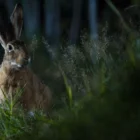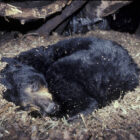How do animals react to a Solar Eclipse?

While humans marvel at this celestial spectacle, animals too experience the profound effects of eclipses. From mammals to birds to reptiles, a diverse array of animals exhibit intriguing behavioral responses during solar eclipses.
Animals and Eclipses
The historical record is replete with fascinating accounts of animal behavior during solar eclipses.
One of the earliest documented observations of animal behavior during a solar eclipse dates back to the Italian monk Ristoro d’Arezzo in 1239. He vividly described how “all the animals and birds were terrified” during a total eclipse, noting that wild beasts became remarkably easy to catch amidst the eerie darkness that descended during totality.
Similarly, the writings of astronomer Christoph Clavius from 1560 provide another historical account of animals’ response to a solar eclipse. Clavius remarked that during totality, “stars appeared in the sky” and witnessed birds falling from the sky in fear of the sudden darkness—a spectacle that he found “marvellous to behold.”
These anecdotes from history, although colorful, are not isolated incidents. Across different cultures and regions, similar observations of animal reactions during solar eclipses have been recorded. In ancient China, for instance, historical texts mention how dogs would bark incessantly and chickens would return to their roosts during an eclipse, reflecting a widespread awareness of animals’ sensitivity to these cosmic phenomena.
Fast forward to modern times, and we find continued interest in studying animal behavior during eclipses. Eclipse-chasers and scientists have documented a myriad of reactions from various species, ranging from insects becoming more active to nocturnal animals emerging as the sky darkens.
Modern Observations
Modern observations of animal reactions during solar eclipses build upon centuries of anecdotal accounts, providing a more nuanced understanding of how various species respond to these celestial events. While historical records offer colorful descriptions, scientific endeavors in recent decades have focused on gathering empirical data to complement these narratives.
Veteran eclipse-chasers and researchers have documented a range of fascinating behaviors exhibited by animals during solar eclipses. One notable observation comes from eclipse-chaser Peter den Hartog, who traveled to Hungary in 1999 and witnessed increased activity among birds and bats during totality. This surge in activity during a normally darkened period hints at the profound impact of the eclipse on nocturnal creatures.
Similarly, eclipse-chaser Dave Balch recounts the striking contrast in noise levels among birds along a pier in Kona, Hawaii, during the 1991 total eclipse. The cacophony of bird calls and chirps abruptly ceased during totality, creating a moment of eerie silence that underscored the animals’ response to the sudden darkness.
Frogs, Giraffes and Raptors
Tora Greve, during an expedition to Zambia in 2001, noticed distinct changes in behavior among frogs and raptors as the eclipse unfolded. The frogs became more vocal, possibly due to altered thermals as the air cooled, while raptors ceased their usual circling behavior, indicating a shift in their flight patterns influenced by the changing light conditions.
Reports from various locations and ecosystems further highlight the diversity of animal reactions. Around water holes in Africa, giraffes were observed running about during totality, possibly in response to the unusual darkness. Whales in the seas breached as the sky darkened, showcasing marine life’s sensitivity to environmental cues.
Furthermore, research has shown that various species exhibit distinct behaviors during eclipses. In zoos and wildlife settings, observations have documented nighttime behaviors in diurnal animals, such as increased activity among nocturnal species as the sky darkens. This suggests that animals may perceive eclipses as a shift in time or environmental conditions, prompting adjustments in their usual routines.
Studies on birds during eclipses have also yielded intriguing findings. Some species may exhibit heightened alertness or anxiety-driven behaviors, while others may remain relatively unaffected.
The Bee Experiment
Among the various studies conducted during solar eclipses, the behavior of honey bees (Apis mellifera) has been a subject of particular interest and scrutiny. A study led by Prashant Waiker and a team of researchers explored the foraging and homing behavior of honey bees during the total solar eclipse of August 21, 2017.
Foraging Behavior During Eclipse
The study observed a significant decrease in foraging activity among honey bees as the solar eclipse progressed. Contrary to previous reports suggesting a complete cessation of foraging during totality, the data revealed that honey bees continued foraging, albeit at reduced levels.
The researchers noted that the level of ambient light played a crucial role in overriding the internal circadian rhythm of foraging honey bees. Colonies with a higher need for foraging showed a lesser decrease in foraging activity compared to satiated colonies. This suggests that individual foraging decisions may be influenced by the overall state of the colony, impacting cost-benefit analyses and resource allocation within the hive.
Homing Dynamics During Eclipse
In addition to foraging behavior, the study also examined the homing dynamics of honey bees, particularly focusing on released workers and drones. Interestingly, very few bees returned to their hives during the totality of the eclipse. However, homing before the total eclipse showed accelerated rates, especially among drones.
These findings indicate that while the homing abilities of honey bees remain intact until the sun is completely eclipsed, they may interpret diminishing light as a potential indicator of deteriorating flight conditions.
Eclipse and zoo Animals
A groundbreaking study conducted at the Riverbanks Zoo in Columbia, South Carolina, during a total solar eclipse provides a wealth of data on the diverse behavioral responses exhibited by 17 species of vertebrates, including mammals, birds, and reptiles. Led by a team of researchers, animal keepers, and volunteers, this study sheds light on how animals from different taxonomic groups react to the rare and impactful meteorological event of a total solar eclipse.
The observations were qualitative and categorized into four overarching behavioral categories: normal/baseline, evening, novel, and apparent anxiety. Live video/audio capture was also utilized for siamangs (Symphalangus syndactylus) to enable subsequent quantitative analysis of behavior during vocalizations.
Diverse Behavioral Responses
The study revealed that approximately 75% of the observed species exhibited some form of behavioral response to the eclipse. Among these responses, the most prevalent was the engagement in established evening or nighttime behaviors. This behavior was observed in a majority of species across different taxonomic groups, indicating a common trend of adjusting activities based on changing light conditions.
The next most frequent behavioral response observed was apparent anxiety, documented in several genera including baboons, gorillas, giraffes, flamingos, and lorikeets. These species exhibited behaviors suggestive of heightened awareness or agitation during the eclipse, highlighting the potential impact of the celestial event on animal stress levels and behavioral patterns.
Additionally, novel behaviors characterized by increased activity were observed in reptiles such as the Galapagos tortoise and the Komodo dragon. These observations provide valuable insights into how different taxa within the animal kingdom respond uniquely to environmental stimuli, including rare meteorological phenomena like total solar eclipses.
The findings from this study contribute significantly to our understanding of how diverse vertebrate species react to total solar eclipses. While anthropogenic influences on animal behaviors, particularly those related to anxiety, cannot be discounted, the observations offer novel insights into the behavioral responses of animals to unique meteorological stimuli.
Update
From the Fort Worth Zoo in Texas to the Indianapolis Zoo in Indiana, scientists and zookeepers witnessed various animals exhibiting unusual behaviors, providing a unique opportunity for research and observation.
At the Fort Worth Zoo, giraffes, gorillas, lions, macaws, and flamingos captured the attention of researchers with their reactions. As darkness descended upon the zoo, many animals displayed behaviors typically associated with nighttime. The Aldabra tortoises, giraffes, elephants, kudu, bonobos, coatis, and gorillas all gravitated toward their barns, mirroring their nightly routine. Surprisingly, even some nocturnal animals, such as a ringtail cat and two owl species, showed increased activity during daylight hours.
Similarly, the Dallas Zoo witnessed giraffes and zebras galloping around, while chimpanzees patrolled their habitat’s perimeter, and gorillas retreated toward their nighttime quarters. An ostrich laid an egg during the eclipse, emphasizing the impact of this celestial event on animal behavior.
Meanwhile, at the Indianapolis Zoo, birds took center stage as macaws, budgies, and other species fell silent and perched high above, emulating nighttime roosting habits. Flamingos gathered together in huddles, echoing the sense of communal protection often seen during the night. Additionally, cheetahs and a warthog displayed behaviors typically reserved for evening hours, suggesting a temporary shift in their internal clocks.
These observations build upon previous research conducted during the 2017 solar eclipse, where similar patterns were noted among zoo animals. Around 75% of species at the Riverbanks Zoo in South Carolina displayed changes in behavior during the eclipse, with many exhibiting behaviors associated with evening or nighttime.










